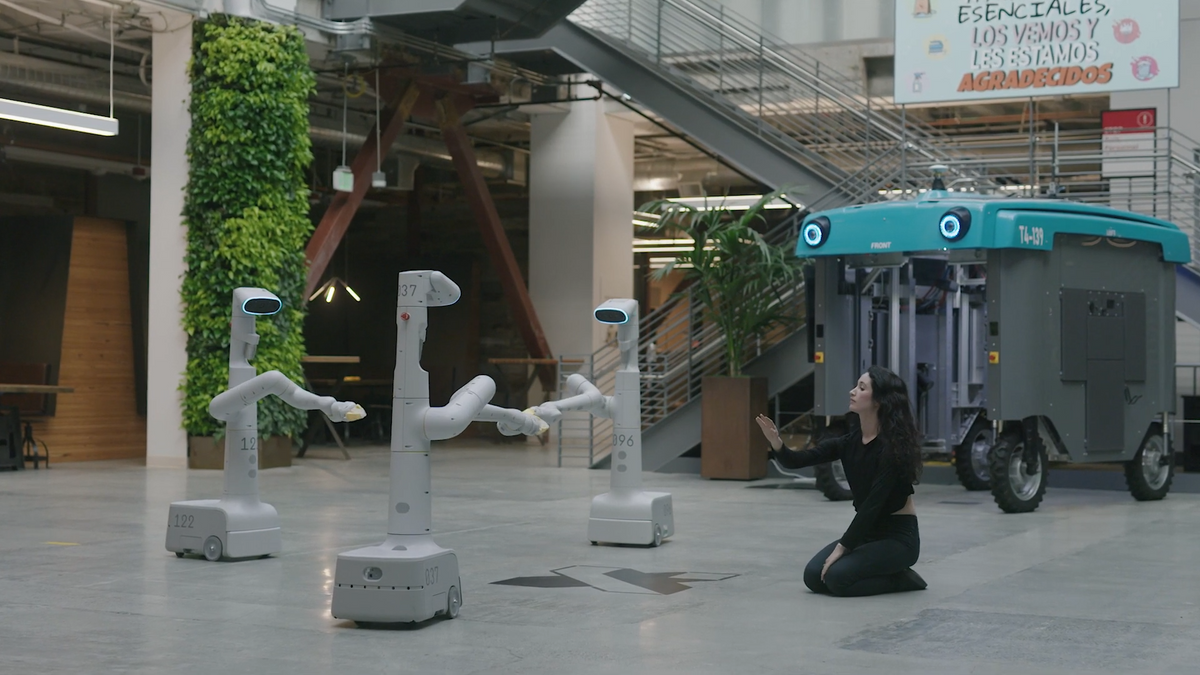Video Friday is your weekly selection of awesome robotics videos, collected by your friends at IEEE Spectrum robotics. We also post a weekly calendar of upcoming robotics events for the next few months. Please send us your events for inclusion.
RoboCup 2022: 11 July–17 July 2022, BANGKOK
IEEE CASE 2022: 20 August–24 August 2022, MEXICO CITY
CLAWAR 2022: 12 September–14 September 2022, AZORES, PORTUGAL
ANA Avatar XPRIZE Finals: 4 November–5 November 2022, LOS ANGELES
CoRL 2022: 14 December–18 December 2022, AUCKLAND, NEW ZEALAND
Enjoy today's videos!
Over the past few months the team at Everyday Robots, alongside Artist-in-Residence Catie Cuan, have been working on an experiment that transforms the robots from everyday physical tools to musical instruments. We map the joint velocities of the robot onto musical tracks, so the robot makes music while it moves—something akin to a “music mode.”
[ Everyday Robots ]
The ROS-Industrial open-source project reached the 10-year mark, and to celebrate, we reached out to the community to share snippets of the great work they have been doing. ROS-I seeks to extend ROS and now ROS 2 to industrially relevant hardware and applications, and the community has been a key part in realizing the successes to date. Thanks to all those that submitted, and we look forward to more success stories in the years to come!
[ ROS-I ]
Planning minimum-time trajectories in cluttered environments with obstacles is a challenging problem. The presented method achieves a 100 percent success rate of flying minimum-time policies without collision, while traditional planning and control approaches achieve only 40 percent. We show the approach in real-world flight with speeds reaching 42 kilometers per hour and acceleration up to 3.6 g.
[ UZH RPG ]
This work tackles the problem of robots collaboratively towing a load with cables to a specified goal location while avoiding collisions in real time. The introduction of cables (as opposed to rigid links) enables the robotic team to travel through narrow spaces by changing its intrinsic dimensions through slack/taut switches of the cable.
[ UC Berkeley ]
After analyzing data gathered when NASA’s OSIRIS-REx spacecraft collected a sample from asteroid Bennu in October 2020, scientists have learned something astonishing: The spacecraft would have sunk into Bennu had it not fired its thrusters to back away immediately after it grabbed dust and rock from the asteroid’s surface. It turns out that the particles making up Bennu’s exterior are so loosely packed and lightly bound to each other that if a person were to step onto Bennu they would feel very little resistance, as if stepping into a pit of plastic balls that are popular play areas for kids.
[ NASA ]
Nicolas Halftermeyer shared this video of a bunch of the cool robots he saw at Automatica 2022 in Germany.
[ Twitter ]
Thanks, Nicolas!
ESA’s four-wheeled, two-armed Interact rover was built by the agency's Human Robot Interaction Lab and modified for the rugged slopes of the volcano. This robot formed part of a team consisting of two DLR rovers—Lightweight Rover Units 1 and 2—along with a fixed ‘lunar’ lander supplying Wi-Fi and power to the rovers, plus a drone for surface mapping. The Karlsruhe Institute of Technology contributed the centipede-like Scout crawler, optimized for tough terrain, which could also serve as a relay between Interact and the lander, boosting its effective area of operations.
[ ESA ]
Building a 159-kilogram (350-pound) autonomous robot designed to go to very dark and tough places takes a while, even in time lapse.
[ WVUIRL ]
Kawasaki Robotics’ Astorino is a six-axis robot arm designed for education. Its structure is 3D printed and easy to repair, and it’s supposedly cheap, although I don’t know how cheap.
[ Kawasaki ]
This video shows uninterrupted operation of ANYmal Bull. The robot performs the following tasks: turning a wheel, pulling a lever, pushing a gate, and pulling a rope to lift a bucket. The robot walks around and up the ramp teleoperated via a remote controller. However, the robot solves each of the manipulation tasks autonomously.
[ SLMC ]
Thanks, Henrique!
Wing is leaving a lot of stuff out in this short video that throws shade at using cars for food delivery, namely that car infrastructure already exists and is useful for all kinds of other things, whereas Wing itself represents a massive amount of dedicated resource investment.
[ Wing ]
Maciej Antonik, Edu4Industry CEO, shares one of his customer success stories, showing that Quanser Autonomous Vehicles Studio is a viable solution that allows students to quickly test and learn pretty complex concepts in robotics.
[ Quanser ]
Global robot scientist Dennis Hong explores a future where humanoids, built to mirror human intellectual and locomotive capabilities, take on repetitive, scaled, and even dangerous tasks.
[ RoMeLa ]
Evan Ackerman is a senior editor at IEEE Spectrum. Since 2007, he has written over 6,000 articles on robotics and technology. He has a degree in Martian geology and is excellent at playing bagpipes.



